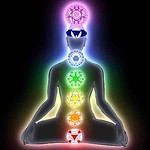Using evidence based science, APSARA’s Holistic Health Program incorporates visualization, breath work, asana (poses), meditation, sound frequency, and acupressure for optimal emotional and physical health.
Science
Research indicates humans hold emotions and beliefs in specific tissues in the body. In a 2014 study, participants were given stimuli through images and sound. Locations in the body where emotions were felt were documented on heat maps. Regardless of gender or culture, participants felt the same emotions (energy) in similar tissues in the body.
This research gives us scientific backing that emotions and physical sensations are linked. Using this research, we can balance emotions in the body by balancing structures in the body.
We are energy. In eastern/Indian philosophy there are seven energy centers in the body called Chakras or “wheels” in Sanskrit. These energy centers regulate processes in the body, which include organ function, immunity, and emotions. “Blocks” in these energy centers can lead to mental and physical imbalances.
Holistic Health Sessions
APSARA’s Holistic Health Program targets each energy center in 8 sessions.

Session 1: Root Chakra (Muladhara)
Psychological imbalances: Disconnection from body and environment, lack of safety and security
Physical imbalances: Coordination issues, poor circulation in lower body, irritable bowel syndrome, colon/rectal issues, hemorrhoids, blood disorders, metabolic disorders, sleeping disorders, eating disorders, weight problems

Sesssion 2: Sacral Chakra (Svadhisthana)
Psychological imbalances: Depression, isolation, jealousy, abandonment, fear of rejection, addictions
Physical imbalances: Lower back pain, urinary and kidney infections, gynecological cysts, abnormal menstruation, infertility, impotence

Session 3: Solar Chakra (Manipura)
Psychological imbalances: Aggression, stubborn, desire for control, perfectionism, critical, demanding, judgmental, competitive, intolerant, laziness, rigid, arrogance, anxiety, low self esteem, powerless
Physical imbalances: Diabetes, celiac’s disease, liver problems, vision related issues, arthritis, ulcers, digestive problems, hair loss, skin issues (psoriasis, acne, rosacea, eczema)

Session 4: Heart Chakra (Anahata)
Psychological imbalances: Social anxiety, self critical, replaying trauma, playing victim, codependency, withdrawn, bitterness, loneliness, suffocating others.
Physical imbalances: Asthma, heart disease, lung disease, breast issues, lymphatic problems, upper back and shoulder issues, wrist and arm pain, high blood pressure, poor blood circulation

Session 5: Throat Chakra (Vishuddha)
Psychological imbalances: Lack of communication, inability to express needs, inability to listen
Physical imbalances: Thyroid disorders, sinus congestion, ear problems, jaw pain, dental issues, neck/shoulder pain

Session 6: Third Eye Chakra (Ajna)
Psychological imbalances: Lack of consciousness, lack of self reflection, lack of intuition, unable to see bigger picture, lack of justice and ethics, lack of awareness in body
Physical imbalances: Vision changes, migraines, dizziness, confusion, surface/trivial communication, insomnia, ADHD, anxiety, paranoia

Session 7: Crown Chakra (Sahasrara)
Psychological imbalances: Lack of connection to environment, unfocused, confusion, hyper spiritualization, lack of direction, inability to set and maintain goals, unable to accept new ideas, close minded, boredom
Physical imbalances: Nerve pain, chemical imbalances, schizophrenia, bipolar, Alzheimer’s, OCD, migraines, depression, insomnia, sensitivity to light and sound, learning disorders, neurodegenerative diseases, muscular diseases, chronic exhaustion

Session 8: Complete Energy Systems
This practice targets all energetic systems in harmony, from Muladhara chakra to Sahasrara chakra. This includes breath work stimulating the entire body, asanas for all energy systems, and a full energy meridian session.
Music frequency is a blend of all Solfeggio sounds. This will raise the vibration of the body in totality. This session is a combination of previous sessions tied together to create a powerful full body practice.

APSARA’s Holistic Health Program will give you the tools, skills, and knowledge to tap into your own guidance. APSARA’s Holistic Health Guide Book is recommended for each participant. Move through the Chakras at your own pace with Holistic Health Videos.
Reference: PNAS Proceedings of the National Academy of Sciences; published 2014; Lauri Nummenmaa, Enrico Glerean, Riitta Hari, and Jari K. Hietanen